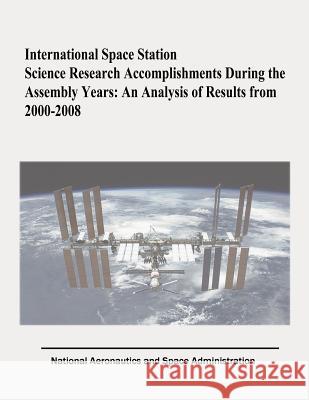International Space Station Science Research Accomplishments During the Assembly Years: An Analysis of Results from 2000-2008 » książka
International Space Station Science Research Accomplishments During the Assembly Years: An Analysis of Results from 2000-2008
ISBN-13: 9781481023924 / Angielski / Miękka / 2012 / 260 str.
International Space Station Science Research Accomplishments During the Assembly Years: An Analysis of Results from 2000-2008
ISBN-13: 9781481023924 / Angielski / Miękka / 2012 / 260 str.
(netto: 84,05 VAT: 5%)
Najniższa cena z 30 dni: 87,52
ok. 16-18 dni roboczych.
Darmowa dostawa!
This report summarizes research accomplishments on the International Space Station (ISS) through the first 15 Expeditions. When research programs for early Expeditions were established, five administrative organizations were executing research on ISS: bioastronautics research, fundamental space biology, physical science, space product development, and space flight. The Vision for Space Exploration led to changes in NASA's administrative structures, so we have grouped experiments topically by scientific themes-human research for exploration, physical and biological sciences, technology development, observing the Earth, and educating and inspiring the next generation-even when these do not correspond to the administrative structure at the time at which they were completed. The research organizations at the time at which the experiments flew are preserved in the appendix of this document. These investigations on the ISS have laid the groundwork for research planning for Expeditions to come. Humans performing scientific investigations on ISS serve as a model for the goals of future Exploration missions. The success of a wide variety of investigations is an important hallmark of early research on ISS. Of the investigations summarized here, some are completed with results released, some are completed with preliminary results, and some remain ongoing. The International Space Station (ISS) celebrated 10 years of operations in November 2008. Today, it is more than a human outpost in low Earth orbit (LEO). It is also an international science laboratory hosting state-of-the-art scientific facilities that support fundamental and applied research across the range of physical and biological sciences. The launch of the first ISS element in 1998, the Russian Zarya module, was a highly visible milestone for international cooperation in human exploration. Later, when the first international crew that included Bill Shepard, Sergei Krikalev, and Yuri Gidzenko, moved into the ISS to establish a continuous human presence in space, a new, global chapter in the history of human space flight was opened. As of this writing, 18 multinational crews comprising 52 astronauts and cosmonauts have called the ISS their home and workplace since November 2000. Dozens more have visited and assisted construction and science activities. While the ISS did not support permanent human crews during the first 2 years of operations (November 1998 to November 2000), it hosted a few early science experiments months before the first international crew took up residence. Since that time-and simultaneous with the complicated task of ISS construction and overcoming impacts from the tragic Columbia accident-science returns from the ISS have been growing at a steady pace. From Expedition 0 through 15, 138 experiments have been operated on the ISS, supporting research for hundreds of ground-based investigators from the U.S. and International Partners. Many experiments are carried forward over several ISS increments, allowing for additional experimental runs and data collection. This report focuses on the experimental results collected to date, including scientific publications from studies that are based on operational data. NASA's priorities for research aboard the ISS center on understanding human health during long-duration missions, researching effective countermeasures for long-duration crewmembers, and researching and testing new technologies that can be used for future Exploration crews and spacecraft. Most research also supports new understandings, methods, or applications that are relevant to life on Earth, such as understanding effective protocols to protect against loss of bone density or better methods for producing stronger metal alloys. Experiment results have already been used in applications as diverse as the manufacture of solar cell and insulation materials for new spacecraft and the verification of complex numerical models for behavior of fluids in fuel tanks
Zawartość książki może nie spełniać oczekiwań – reklamacje nie obejmują treści, która mogła nie być redakcyjnie ani merytorycznie opracowana.











